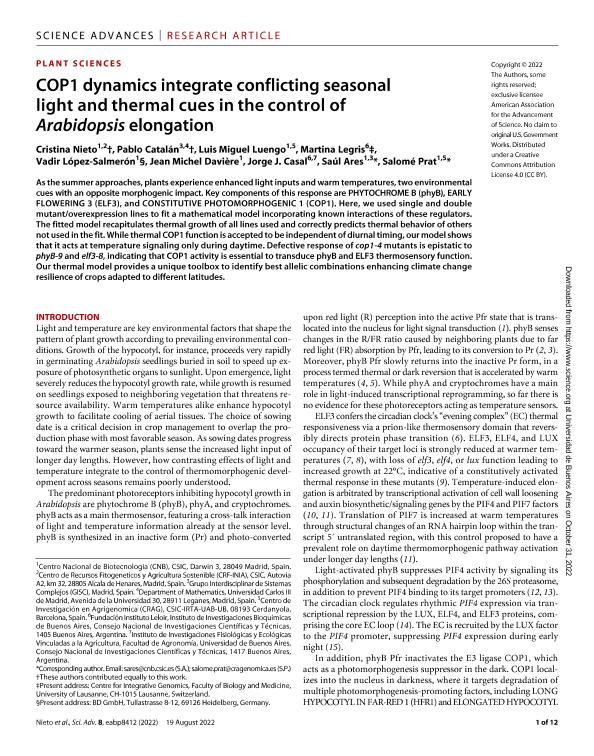Artículo
COP1 dynamics integrate conflicting seasonal light and thermal cues in the control of Arabidopsis elongation
Nieto, Cristina; Catalán, Pablo; Luengo, Luis Miguel; Legris, Martina ; López Salmerón, Vadir; Davière, Jean Michel; Casal, Jorge José
; López Salmerón, Vadir; Davière, Jean Michel; Casal, Jorge José ; Ares, Saúl; Prat, Salomé
; Ares, Saúl; Prat, Salomé
 ; López Salmerón, Vadir; Davière, Jean Michel; Casal, Jorge José
; López Salmerón, Vadir; Davière, Jean Michel; Casal, Jorge José ; Ares, Saúl; Prat, Salomé
; Ares, Saúl; Prat, Salomé
Fecha de publicación:
08/2022
Editorial:
Science Advances is the American Association for the Advancement of Science
Revista:
Science Advances
ISSN:
2375-2548
Idioma:
Inglés
Tipo de recurso:
Artículo publicado
Clasificación temática:
Resumen
As the summer approaches, plants experience enhanced light inputs and warm temperatures, two environmental cues with an opposite morphogenic impact. Key components of this response are PHYTOCHROME B (phyB), EARLY FLOWERING 3 (ELF3), and CONSTITUTIVE PHOTOMORPHOGENIC 1 (COP1). Here, we used single and double mutant/overexpression lines to fit a mathematical model incorporating known interactions of these regulators. The fitted model recapitulates thermal growth of all lines used and correctly predicts thermal behavior of others not used in the fit. While thermal COP1 function is accepted to be independent of diurnal timing, our model shows that it acts at temperature signaling only during daytime. Defective response of cop1-4 mutants is epistatic to phyB-9 and elf3-8, indicating that COP1 activity is essential to transduce phyB and ELF3 thermosensory function. Our thermal model provides a unique toolbox to identify best allelic combinations enhancing climate change resilience of crops adapted to different latitudes.
Archivos asociados
Licencia
Identificadores
Colecciones
Articulos(IFEVA)
Articulos de INST.D/INV.FISIOLOGICAS Y ECO.VINCULADAS A L/AGRIC
Articulos de INST.D/INV.FISIOLOGICAS Y ECO.VINCULADAS A L/AGRIC
Citación
Nieto, Cristina; Catalán, Pablo; Luengo, Luis Miguel; Legris, Martina; López Salmerón, Vadir; et al.; COP1 dynamics integrate conflicting seasonal light and thermal cues in the control of Arabidopsis elongation; Science Advances is the American Association for the Advancement of Science; Science Advances; 8; 33; 8-2022; 1-13
Compartir
Altmétricas



